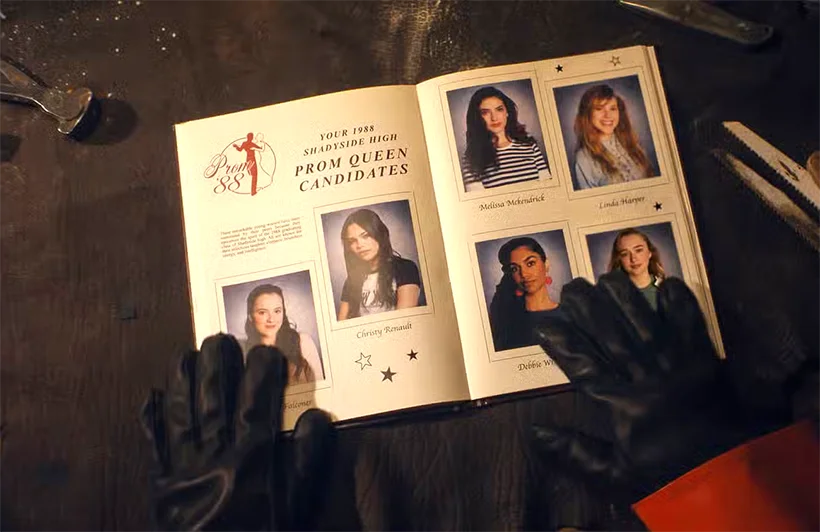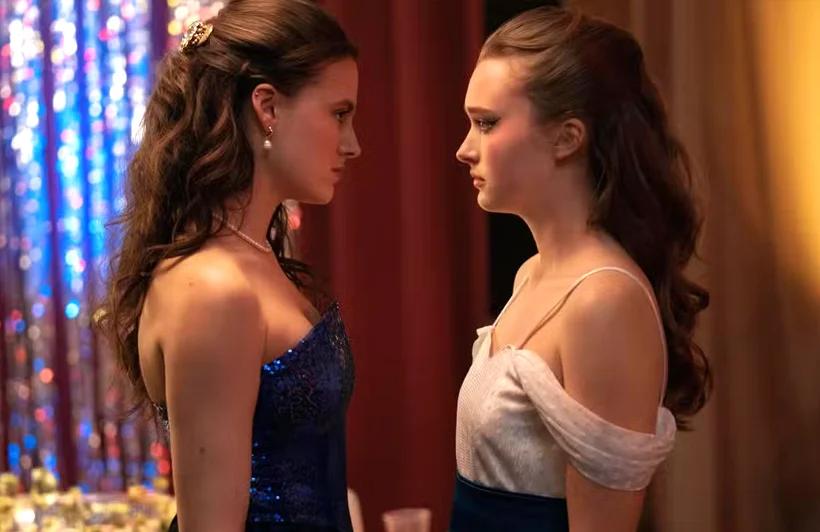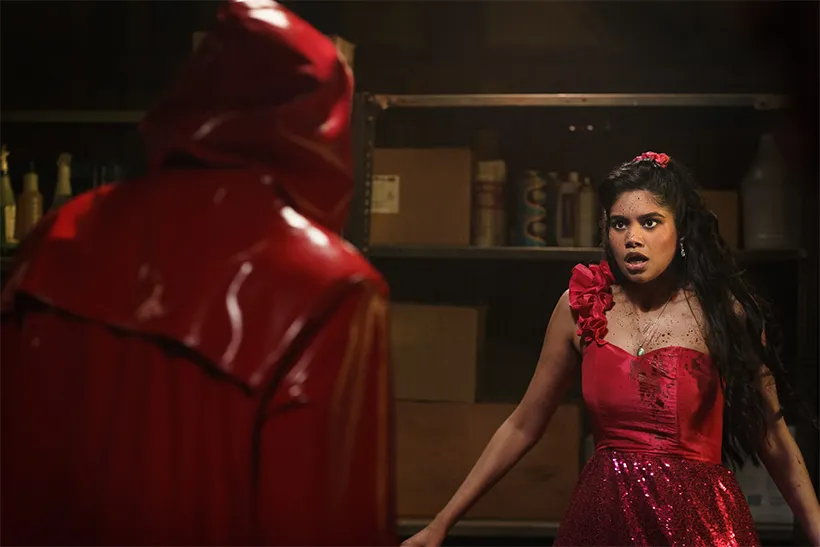Type and hit Enter to search
Experts in aesthetic surgery, dermatology, and beauty bring you the latest trends, research, and advice to help you make informed decisions about your appearance and health.
A web platform dedicated to aesthetic surgery, dermatology, and beauty, where expertise meets innovation, and your desires and needs become our mission. In a world where appearance and health go hand in hand, our platform leads the revolution, delivering the latest trends, research, and expert advice directly to you.
Our team consists of highly skilled professionals in the fields of aesthetic surgery and dermatology, committed to providing reliable information and guidance that will help you make informed choices about your appearance and well-being. We understand that every individual has unique needs and desires, which is why we approach each person with the utmost care and professionalism.
Powered by Aestetica Web Design © 2024
I Braved Fear Street: Prom Queen—Here’s the Ending Explained
I pressed play on Fear Street Prom Queen expecting blood, dread, maybe a clever nod to Stine. Instead, I got a prom-themed shrug in VHS cosplay. The kills were limp, the dialogue dead on arrival, and the suspense buried under 80s karaoke and cardboard characters. I don’t blame the cast—I blame the algorithm. This is Fear Street Prom Queen Explained for anyone trying to figure out how a once-brilliant franchise tripped in heels and face-planted into mediocrity.
Fear Street Prom Queen Explained – A Bloody Mess Without the Bite?
Netflix’s revival of R.L. Stine’s iconic universe: Bold move or big mistake?
After the surprising success of the original trilogy, Fear Street: Prom Queen lands on Netflix with all the prom-night glitz and gore you’d expect — but also a creeping sense that the magic might’ve faded. As a 2025 standalone, the film’s blood-soaked arrival doesn’t just extend the universe, it tests whether Shadyside still has enough secrets left to spill.
This installment, loosely spun from R.L. Stine’s teen horror classic, isn’t trying to reinvent the wheel — or the butcher knife. But with a franchise so rooted in tonal tightrope-walking, a misstep feels seismic. The result? A film that wants to be the next scream queen in the streaming lineup, but instead ends up as a prom queen without a crown. If you’re searching for a detailed Fear Street: Prom Queen Netflix review that explains both the thrills and the stumbles, this is where the post-mortem begins.
Dead on Arrival or Cult Classic in Waiting?
Let’s not pretend this wasn’t one of Netflix’s major horror bets for 2025. Positioned as a nostalgic callback and potential relaunch pad for more Fear Street chaos, Prom Queen carries the burden of expectations — and a prom sash soaked in them. While it nods dutifully to the trilogy’s signature blend of camp and carnage, the follow-through feels algorithmic.
In a post-Stranger Things landscape where even low-budget horrors need prestige vibes, Fear Street: Prom Queen can’t decide if it wants to be an 80s slasher homage or a viral-ready content drop. As a result, what should’ve been a delightfully deranged Fear Street: Prom Queen review becomes a checklist of missed opportunities.

80s Aesthetic or Costume Party Cringe?
When Big Hair Isn’t Enough
Ah yes, the 80s — a decade of hairspray, horror, and hedonism. Fear Street: Prom Queen tries to resurrect it all in a single blood-soaked evening. From a design perspective, it’s dripping with callbacks: acid-wash denim, locker-lined hallways, and a prom night that looks ripped from a Degrassi High fever dream. But instead of fully immersing us in the era, the production leans so hard into cliché that it feels like someone shouted “theme party” and forgot to build a world around it.
That’s not to say the effort isn’t visible. The film’s art direction nails the textures of teen ephemera — glitter corsages, tacky tiaras, and letterman jackets that practically scream “I’ll be dead in 20 minutes.” But Fear Street: Prom Queen’s 80s fashion lacks the lived-in feel that makes a setting breathe. There’s more authenticity in Heathers’ hallway scenes than in this entire high school.
If you came hoping to soak in authentic Fear Street: Prom Queen 80s fashion, the costume design gets the shapes and colors right — but never gives them character. It’s more catalog than culture.
A Mixtape in Search of a Mood
Now let’s talk soundtrack — or rather, sonic wallpaper. The film weaponizes a cascade of vintage bangers: Madonna, Tears for Fears, Echo & the Bunnymen — all of which hit the right notes on paper. But they’re often used as shortcuts to emotional impact the script doesn’t earn. It’s a technique as old as Donnie Darko, but here it feels more like a DJ stuck on autoplay.
Rather than build suspense with score and silence, Prom Queen leans on needle drops to sell scenes that barely hold together. What should be moments of creeping dread become music-video vignettes, complete with freeze-frame aesthetics and slow-mo that borders on parody.
For a film marketed around its nostalgic flair, the Fear Street: Prom Queen soundtrack turns out to be one of its biggest misfires — all volume, no atmosphere. The 1988 prom night should’ve been a pulsing heart of tension and release. Instead, it’s a playlist in search of a pulse.

Character breakdown: The good, the bad, and the underused in Fear Street: Prom Queen
Lori Granger: The rise of Fear Street’s resilient final girl
Lori Granger enters Fear Street: Prom Queen wearing Shadyside’s judgment like part of her wardrobe. Played by India Fowler with a mix of restraint and steel, Lori isn’t the usual slasher lead. She doesn’t scream; she calculates. Her low social status and her family’s scandal mark her from the start, casting a shadow the town never let go.
Her arc doesn’t rely on sudden transformation. Lori’s survival instinct has been active for years. Her strength isn’t discovered in crisis—it’s shown in how she’s endured silent suspicion since childhood. Running for prom queen isn’t about popularity; it’s about reclaiming the Granger name from whispered accusations.
From overlooked to unforgettable
Lori becomes the final girl not through spectacle but persistence. The dialogue gives her little depth, but Fowler pulls emotion from minimal material, especially in scenes with Megan. Her last line—“I’m Lori f\*cking Granger”—works not as bravado but as conclusion. It’s the film’s one moment of real narrative payoff.
This analysis of Lori Granger as the final girl in Fear Street: Prom Queen shows how a flat script still produced a character with staying power. Even with structural issues, she stands out. If the franchise continues, Lori’s resilience should be its foundation.
Tiffany Falconer: Mean girl archetype or misunderstood villain?
Tiffany Falconer, played by Fina Strazza, enters the story as if she invented the concept of social rank. She’s flawless, cutting, and rigidly controlled. On the surface, she’s built from stock characters—part Regina George, part Heather Chandler—but without irony or depth.
There is a more complex figure beneath the surface. Tiffany comes from a home where affection is conditional, and failure is not tolerated. Her parents don’t just support her success—they enforce it. The film touches on this background but never stays there long enough to build tension. Tiffany is not just manipulative. She was taught that violence is a form of loyalty.
A villain by nurture, not nature
Her final scene with Lori is chaotic, raw, and emotionally regressed. It’s not the climax of a schemer. It’s a breakdown from a girl whose worldview has just collapsed. Tiffany doesn’t act to win. She reacts to losing everything she was conditioned to believe mattered.
This analysis of Tiffany Falconer as a villain in Fear Street: Prom Queen makes it clear: the potential for nuance was present. The film just didn’t commit to it.
Wasted potential: The supporting cast that deserved better
Ariana Greenblatt and Suzanna Son—blink and you’ll miss them
There’s a familiar beat in horror: strong actors appear, spark interest, then vanish without impact. That’s the case here. Ariana Greenblatt and Suzanna Son show early promise, but the film sidelines them fast. Megan brings a grounded presence, playing the genre-aware friend with restraint, but she gets rushed offscreen before her arc can land.
Greenblatt’s role is especially thin. Her presence fades into the background. These actors could have balanced the narrative or deepened the stakes. Instead, they’re reduced to minor roles without payoff.
The adult cast: talented, wasted, invisible
Katherine Waterston, Chris Klein, and Lili Taylor bring name recognition and potential. But the film gives them no space. Their roles feel ornamental, not essential. They enter scenes, deliver flat exposition, and exit without consequence.
This examination of underused supporting characters in Fear Street: Prom Queen shows a recurring issue: the script avoids complexity. Whenever a subplot threatens to expand the story, it’s dropped. What remains is a cast with capacity, wasted by a structure that can’t support them.
The film assembles strong performers but gives them nothing to build. In a sharper draft or under different direction, they could have mattered. Instead, they’re left on the edge of the frame—present, but irrelevant.

Gore, guts, and glory: Evaluating horror elements in Fear Street: Prom Queen
Analyzing Fear Street’s gore factor: Gruesome kills and missed opportunities
For a franchise that gleefully embraced over-the-top horror in its original trilogy, Fear Street: Prom Queen feels oddly restrained in its violence. Yes, the bodies drop. And yes, technically, there’s a hefty kill count—somewhere around a dozen characters, depending on how you tally the prom night chaos. But it’s the how that disappoints. Most of the deaths lack flair, tension, or creativity. It’s like someone put “slasher film” into an AI and asked for PG-13 violence with R-rated blood.
There’s one moment—a poor kid tries to open a door with freshly severed hands—that briefly jolts the viewer awake, offering the kind of gnarly, absurd visual horror Fear Street usually thrives on. But it’s a one-off, and everything around it plays like a low-budget homage to better kill sequences from Friday the 13th or Scream—only without the style or suspense.
FX fatigue and the horror of cheapness
The special effects lean heavily on practical blood, but without much finesse. It’s gore for gore’s sake, sprayed around like someone’s trying to make up for the lack of scares by upping the red stuff. And still, somehow, it feels bloodless. There’s no weight behind the violence, no time spent building dread or paying off narrative tension. The film jumps from one kill to the next like it’s following a checklist, and the result is cinematic numbness.
This evaluation of gore and kill count in Fear Street: Prom Queen highlights a central problem: the violence doesn’t shock, it shrugs. For a story supposedly “too violent” for young audiences, the final product plays like horror-lite dressed in prom attire—messy, yes, but forgettable.
The scares that weren’t: Why Prom Queen fails to frighten
Jump scares that barely hop
Let’s get one thing straight: this movie isn’t scary. Not even in a campy, scream-in-unison-with-your-friends kind of way. The jump scares are telegraphed from a mile away—doors creak, lights flicker, someone gasps, and then… nothing. It’s the horror equivalent of someone sneaking up behind you and saying “boo” with a yawn.
Where the Fear Street trilogy managed to build palpable dread through sound design, pacing, and atmosphere, Prom Queen opts for horror-by-template. The prom massacre, which should be the film’s signature bloodbath, lands like a wet balloon drop. There’s no sense of panic, no sustained chaos—just a series of mildly frantic beats edited like a music video with budget constraints.
Atmosphere? We left that in the ’70s
And that’s the real issue. The film has zero atmosphere. Lighting is flat. Cinematography is uninspired. Even the soundtrack—which should be pumping tension into every frame—feels oddly detached. Instead of enhancing unease, it competes with it. You can almost feel the missed opportunities: a bathroom mirror that should’ve dripped suspense, a slow walk down a hallway that deserved more than dead air and a violin scrape.
This analysis of Fear Street: Prom Queen’s effectiveness as a horror film boils down to this: it’s horror in name only. If your idea of fear is watching emotionally hollow characters sprint through moodless scenes, you’ll be mildly alarmed. For everyone else, it’s like watching someone rehearse a haunted house script with the lights on.
Controversies and backlash: Examining criticisms of violence and drug portrayal
Trigger warnings and teen horror politics
While the film didn’t exactly court mainstream controversy, Fear Street: Prom Queen did spark a few conversations online around its violent content—particularly the sheer volume of deaths at a supposedly teen-targeted prom. Some viewers flagged the body count as excessive, not in a gleeful Final Destination way, but in a gratuitous, mean-spirited fashion. Others criticized the tonal inconsistency: one minute it’s snarky high school drama, the next it’s butcher knives through cheerleaders’ backs.
Then there’s the issue of drug content. The movie tosses in scenes of recreational use and substance-fueled behavior like it’s trying to check the “edgy teen movie” box, but these moments feel neither authentic nor satirical. Instead, they come off like a writer who watched Euphoria once and panicked.
A hollow provocation without the bite
Parental guidance sites flagged the film’s “extreme violence, drug use, and thematic content,” and while that’s technically accurate, it also feels like overcompensation. The film seems desperate to be dark and edgy but lacks the narrative discipline to do anything meaningful with the material. It’s violence and drugs without commentary, just window dressing to look cool in thumbnails.
This criticism of violence and drug portrayal in Fear Street: Prom Queen isn’t about pearl-clutching. It’s about wasted potential. Horror has always been a great vehicle for metaphor and message. Here, it’s just noise—bloody, chemically enhanced, but ultimately empty. The film doesn’t challenge boundaries so much as bump into them and shrug.
Easter eggs, connections, and theories: Diving deeper into Fear Street: Prom Queen
Decoding the subtle links: How does Prom Queen connect to the trilogy?
If you squint—and let’s be honest, this film makes you squint a lot—you’ll catch a few nods to the original Fear Street trilogy. The most obvious comes early on when Lori stares at a poster of Camp Nightwing, the blood-soaked summer camp from Fear Street: Part Two – 1978. It’s not a flashback so much as a whisper, a quick visual cue meant to say, “Hey, remember when this franchise had real stakes?”
The camera lingers just long enough for fans to recognize the callback, before cutting to a brief, stylized flashback that feels more like a trailer insert than an organic part of the narrative. It’s nostalgia deployed like a sticker slapped on a notebook: decorative, sure, but not structurally useful.
The curse lives on—or does it?
The more intriguing reference comes during a post-massacre cleanup when a first responder grimly mutters, “Worse than ’78.” That single line places Prom Queen squarely in the same blood-soaked timeline as its predecessors, even if it never does the work of building on their mythology.
Set once again in the cursed town of Shadyside, the film operates in the shadow of past horrors but never commits to continuing the saga of the Goode family or the supernatural curse. This explanation of Fear Street: Prom Queen’s trilogy connections reveals a frustrating halfway point: the film winks at the trilogy, nods to Shadyside’s dark legacy, but never really says anything new. It’s all hat, no hex.
The post-credits tease: What the hidden scene means for the franchise
Blood, symbols, and the Witch’s Mark
Now here’s where things get interesting—finally. The mid-credits scene shows Nancy Falconer dead on the floor, her blood pooling into a familiar shape. For fans of the trilogy, the moment is electric: it’s the Witch’s Mark, also known as the Devil’s Mark, a symbol tied directly to the Goode family’s sacrificial pact with darkness.
If you remember the end of Fear Street: Part Three – 1666, the same symbol appears in the book that gets swiped just before credits roll. Its reappearance here suggests Nancy wasn’t just an unstable suburban sociopath—she might’ve been the Goode family’s next designated sacrifice, destined to spread blood across Shadyside. Whether that’s retroactive continuity or a seed for the next film, it’s the first and only moment in Prom Queen that hints at deeper mythos.
Setting the stage for something darker
The shape-shifting blood symbol could be a breadcrumb toward a larger supernatural reckoning—perhaps Fear Street 4 will tie together disparate killers under a single, satanic thread. Or maybe we’re just meant to feel clever for spotting the callback. Either way, this analysis of Fear Street: Prom Queen’s mid-credits scene suggests Netflix hasn’t entirely abandoned the cursed soil of Shadyside. They’re just being maddeningly slow about planting anything new.
The bigger question: if Nancy was a chosen vessel of evil, how far back does the curse go? And more importantly, what other characters—past or future—might be unknowingly tied to the Goode family’s blood pact?
Fan theories and speculation: Could a sequel or new season be coming?
What the whispers say
Let’s talk Fear Street 4—because fans are already doing it. Despite mixed reviews, there’s a low hum online suggesting this isn’t the end of the prom massacre saga. Rumors are circulating that Netflix is weighing another entry, possibly a direct sequel, depending on how Prom Queen performs in global streaming numbers. No official greenlight has been announced, but don’t be surprised if we get a teaser in the next year. After all, Netflix loves a franchise, even a bleeding one.
There’s also chatter about cast contracts. India Fowler’s name keeps coming up as a potential returnee, which tracks—her Lori Granger is one of the few characters worth building on. Some fans speculate that Tiffany could also make a comeback in Scream-style ghost form or hallucination, especially if the next film leans more into the psychological horror territory the trilogy occasionally teased.
Where could the story go next?
Here’s the theory with the most traction: Fear Street: Prom Queen may serve as the unofficial start of a new arc—a modern Shadyside chapter that brings in fresh blood but roots everything in the original curse. Think of it as American Horror Story meets It Follows, with a rotating cast of unlucky teens doomed to dance on cursed soil. The Goode family’s influence may no longer be active, but the evil they unleashed could still be spreading through Shadyside’s bloodline.
This summary of sequel theories and renewal status for Fear Street: Prom Queen reflects what many fans feel—disappointment, yes, but also curiosity. The film may have fumbled its execution, but the mythos still holds weight. If Netflix dares to revisit Shadyside, they’ll need more than nostalgia and easter eggs. They’ll need vision. And probably a better prom committee.
From book to screen: Evaluating Fear Street: Prom Queen’s adaptation success
R.L. Stine’s vision vs Netflix’s execution: The great adaptation debate
R.L. Stine’s Prom Queen novel—yes, the one that lived in your backpack next to a Lisa Frank folder and a cracked compact mirror—was never high literature, but it was tight, fun, and full of teen paranoia. It leaned into mystery, not massacre. The original plot followed Lizzie McVay as she tried to unravel who was killing prom queen nominees in her school, unfolding as a genuine whodunit rather than a blood-soaked slasher. There was suspense, misdirection, and (crucially) no decapitated limbs flung across locker rooms.
Netflix’s Fear Street: Prom Queen, however, throws that measured tension out the window and trades it for rapid-fire deaths, over-the-top gore, and a killer reveal that’s less Scooby-Doo and more suburban Midsommar. The book had restraint. The movie has red corn syrup and a deadline.
What’s missing—and what’s mangled
Gone are the book’s psychological twists and dread-soaked pacing. Instead, we get Lori Granger—an original character created for the film—who bears little connection to the book’s protagonist aside from the whole “someone’s murdering prom nominees” angle. And while the film tries to inject emotional depth through Lori’s family trauma, it leaves behind the intricately woven paranoia and red herrings that made the original story work.
The killer’s motive is also wildly different. In the novel, the murders stem from jealousy and a desire for social vengeance—classic teen thriller fare. In the film, we’re suddenly dealing with a murderous family trio and a blood curse tangent that feels stapled on. This analysis of book and movie differences in Fear Street: Prom Queen doesn’t just highlight changes—it underlines the tonal shift from chilling to chaotic. Stine’s flair for suspense is buried beneath spectacle, and that shift drains the story of its identity.
The fandom speaks: How fans are reacting to Netflix’s interpretation
Rotten scores and mixed feelings
Let’s just say Fear Street: Prom Queen isn’t getting crowned at the fandom banquet. While the original trilogy basked in critical praise (all hovering comfortably above 80% on Rotten Tomatoes), this one limped into the review circuit with scores as deflated as the film’s jump scares. Fan consensus on social media? Meh, with a side of “what happened to the writing?”
On platforms like Reddit and Letterboxd, viewers pointed out the weak character arcs, lack of suspense, and tonal confusion. Many longtime fans of the books felt betrayed by what they described as a “sloppy, soulless adaptation” that bore almost no resemblance to the Prom Queen they remembered. Instead of honoring Stine’s structure, the film opts for a Netflix-by-numbers approach that left horror enthusiasts cold and nostalgic fans annoyed.
Nostalgia backlash and adaptation fatigue
The backlash isn’t just about the gore overload—it’s about missed opportunities. This could’ve been a smart, tight thriller with a modern edge. Instead, Netflix went with the loudest possible version of the story, prioritizing quantity (of blood, characters, bodies) over quality. In multiple fan threads, users joked that the only thing adapted from the book was the title.
Still, not everyone was ready to write it off. Some viewers appreciated the campy vibes and 80s aesthetic, arguing that it wasn’t meant to be faithful so much as reimagined. But even among this more forgiving crowd, one sentiment kept bubbling up: “It’s fine, I guess, but it’s no Fear Street 1994.” This analysis of fan reaction and reception to Fear Street: Prom Queen suggests that while the audience was willing to embrace change, what they got felt hollow, rushed, and disappointingly forgettable.
Turns out, nostalgia’s a tricky thing—you can update the packaging, but if you forget the soul, the fans will notice. And tweet about it. Relentlessly.
SOURCES:
Murder, mayhem, and a crown: ‘Fear Street’ makes prom a killer affair, R.L. Stine Admits Which of His Goosebumps Series He Thinks Is ‘Really Bad’: ‘It’s a Terrible Book’ (Exclusive), Fear Street: Prom Queen director aimed to make the film feel like a lost slasher classic, Fear Street: Prom Queen (2025) – Full cast & crew – IMDb, Exclusive Look At Netflix’s First New Fear Street Movie In 4 Years, Prom Queen, ‘Fear Street: Prom Queen’ Trailer: Axe Murderer Hunts High Schoolers in Netflix’s Fourth R.L. Stine Horror, Fear Street: Prom Queen | Rotten Tomatoes, Fear Street: Prom Queen (2025) – IMDb, Fear Street: Prom Queen: Return to Shadyside with the Killer Trailer



